Proton accelerators single event effects test procedure for COTS electronics: approach to reduce cost and time
- Posted by Alexey Akhmetov
- On December 3, 2019
- 0
Introduction
- SPecialized ELectronic System (SPELS) is radiation test laboratory founded in 1989. More than 10000 IC’s were tested in the last 15 years. About 50% of IC’s radiation tests in Russia are done by SPELS. It is an innovative company and a lot of original radiation test methods and procedures were developed and implemented by SPELS: X-ray test method, focused laser test procedure, a lot of Russian radiation test standards.
- First paper about “PROMETEUS” medical proton accelerator used for IC’s radiation test: A.O. Akhmetov, A.V. Yanenko, A.I. Bazhan “Proton accelerator with adjustable energy for ICs radiation test” (2013) Proceedings of the European Conference on Radiation and its Effects on Components and Systems, RADECS, № 6937364
- COTS electronics were, are and will be used in space missions!
- There are a lot of modern ICs (ADC, DAC, FPGA, RAM, SRAM, SoC, Microprocessor) for space applications with sub-90nm process and even low energy protons are able to produce enough energy in sensitive volume to cause single event effects (upsets, transients, etc.).
- Single event upset (SEU) critical charge for modern ICs is equal to 0.1….1 fC.
- Upset threshold LET is close to 0.1 MeV×cm2/mg.
- Critical orbits for proton upsets:
- International Space Station (South Atlantic Anomaly);
- Circular orbits with altitudes 1500…4000 km;
- Polar orbits with altitude 800 km;
- GEO, solar flares.
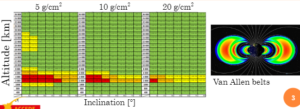
Proton Test Facility
- Proton accelerator “PROMETEUS” is a medical facility certified in 2018 for IC’s radiation experiments;
- Proton energy from 30 MeV to 250 MeV with ±0.15% error;
- Proton flux in a bunch 107…109;
- Scanning system:
– Y-axis ±50 mm, speed is up to 2000 mm/s;
– X-axis ±350 mm, speed is up to 700 mm/s; - Minimum scan step is 1 mm;
- Minimum proton beam diameter is 2…4 mm;
- Aluminum foils is used to decrease proton energy less than 30 MeV.
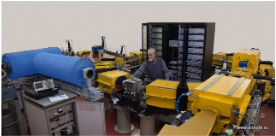
Test Facility – Proton Accelerator “Prometeus”
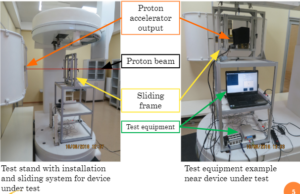
Application for COTS electronics
- It’s easier to choose IC’s from different manufacturers.
- It’s possible to test COTS PC/104 modules. The probability of all critical IC’s at the PCB decapsulation tends to zero and heavy ion test is impossible.
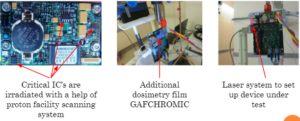
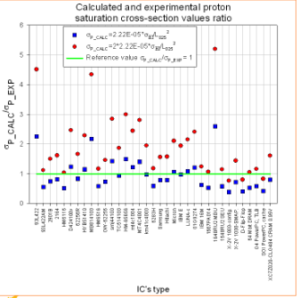 3. It’s possible to calculate heavy ion cross-section from proton cross-section data.
3. It’s possible to calculate heavy ion cross-section from proton cross-section data.
There are several semiempirical equations [1], [2] from Peterson, Barak and others to calculate proton SEU cross-section from heavy ion data and vice versa. More precise Monte-Carlo methods are also available.
It’s possible to do only one experiment (proton or heavy ion) to reduce time and cost. Proton test is less expensive and faster than heavy ion test.
*Experimental data from [1], [2] and SPELS database.
COTS IC’s experimental results example
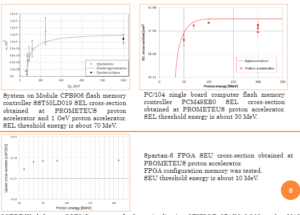
Conclusion
- Proton accelerator test helps designer to choose more radiation tolerant IC from different vendors.
- COTS electronics usually has low proton energy SEE threshold and it’s possible to calculate heavy ion cross-section and threshold LET from “good” proton experimental data (saturated cross-section and energy threshold). Modern mass production COTS nowadays has 7-nm design rules so SEE proton energy threshold would be lower and lower.
- Proton radiation test for COTS single board modules (PC/104 or similar) is a way to do fast and less expensive SEE test than heavy ion test.
- Total ionizing dose effects during proton irradiation are able to cause IC’s failure.
References
- Edward Petersen, Single Event Effects in Aerospace, IEEE 2011.
- J.Barak, Simple Calculation of Proton SEU Cross Sections from Heavy Ion Cross Section, IEEE Transactions on Nuclear Science, Volume 53, Issue 6, Dec.2006, pp.3336-3342
- N.A. Dodds, M.J. Martinez, P.E. Dodd, M.R. Shaneyfelt, F.W. Sexton, J.D. Black, D.S. Lee, S.E. Swanson, B.L. Bhuva, K.M. Warren, R.A. Reed, J. Trippe, B.D. Sierawski, R.A. Weller, N. Mahatme, N.J. Gaspard, T. Assis, R. Austin, S.L. Weeden-Wright, L. W. Massengill, G. Swift, M. Wirthlin, M. Cannon, R. Liu, L. Chen, A. T. Kelly, P. W. Marshall, M. Trinczek, E. W. Blackmore, S. J. Wen, R. Wong, B. Narasimham, J. A. Pellish, and H. Puchner, ‘The Contribution of Low-Energy Protons to the Total On-Orbit SEU Rate’, IEEE Transactions on Nuclear Science, vol. 62, no. 6, pp. 2440–2451, Dec. 2015.
- A.O. Akhmetov, A.V. Yanenko, A.I. Bazhan “Proton accelerator with adjustable energy for ICs radiation test” (2013) Proceedings of the European Conference on Radiation and its Effects on Components and Systems, RADECS, № 6937364
Latest posts by Alexey Akhmetov (see all)


0 comments on Proton accelerators single event effects test procedure for COTS electronics: approach to reduce cost and time